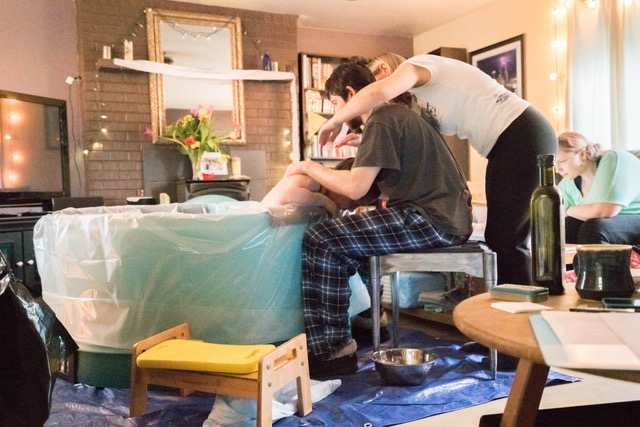Today’s Blog Post is written by team member Manon Banuelos. Many thanks for sharing this valuable information!
If you've recently found out you are expecting (or even if you are already well into your second or third trimester!), it is likely you are already inundated with many choices and options to consider for both yourself and your baby. For many, one of the first considerations soon after confirming a pregnancy is who to select as a maternity care provider and where to give birth. For some women, the choice is a simple one if they already have a good relationship with a care provider who has been providing well-woman care and is able to continue care during pregnancy and birth. Or perhaps it is a matter of choosing a provider that is covered by a particular insurance plan. For others, determining who to have as their provider can be a process fraught with uncertainty and questions.
The reality is that the person you will choose for your maternity care (and where you choose to birth your baby) can make a huge impact on the type of care you receive, your labor and birth experience (including the choices and options you are offered), and your overall satisfaction with your birth.
In the Seattle area, we are fortunate to have a plethora of options when it comes pregnancy and birth. So what are the options out there and how do you go about navigating the task of selecting a care provider that will be a good fit for you?
In choosing your care provider (and depending on your location), your options will likely include obstetricians (OBGYNs), family physicians, and midwives:
OB/GYNS have graduated from medical school and had extensive training in obstetrics and gynecology.
Family physicians have graduated from medical school with additional training in maternity and pediatrics and a focus on the health-care needs of the whole family.
Certified Nurse Midwives (CNMs) have attended nursing school, followed by three years of midwifery training, and often see patients through hospital midwifery groups.
Licensed Midwives (LMs) and Certified Professional Midwives (CPMs) typically attend out-of-hospital births. In Washington, LMs have completed three years of training in midwifery, have passed the North American Registry of Midwives exam, and have attended a minimum number of births. Many LMs are also CPMs and their care is very similar (more information about CPMs can be found on the North American Registry of Midwives website).
The Our Bodies Ourselves website has more information on the different options when it comes to choosing a maternity care provider.
Where you give birth and who provides your maternity care are closely connected. In deciding on birth location, it is important to make the distinction between a freestanding birth center and a birth center attached to a hospital.
-Birth centers that are part of a hospital are usually simply an extension of the hospital; patients there are attended by OBGYNs and CNMs and are offered the same medical procedures available in hospitals (for example, epidural analgesia and other forms of pain medication, labor induction and augmentation, cesarean birth, etc.).
-Freestanding birth centers, on the other hand, and home births are typically attended by direct-entry midwives such as certified professional midwives (CPMs) and licensed midwives (LMs), though can also be attended by certified nurse midwives (CNMs). Birth at home or in a freestanding birth center with a midwife is a safe option for a person with a healthy low-risk pregnancy who is hoping for an unmedicated birth experience. According to Penny Simkin, author of Pregnancy, Childbirth and the Newborn, “For women who have low-risk pregnancies, good prenatal care, skilled caregivers, and hospital backup, planned out-of-hospital births are as safe for mothers and babies as planned hospital births—sometimes even safer.”
Caregivers have different approaches to maternity care and it is crucial to understand how your provider views pregnancy and birth. The table below highlights some general key differences in the midwifery and medical models, though it is important to note that care providers will vary widely depending on their individual philosophy and personality:
Home Birth with a Licensed Midwife
Expectant Management Model (Midwifery Model)
Birth is a normal physiological event that is part of a woman’s life.
Belief in the integrity of birth; uses technology if appropriate and proven
Appropriate option for low-risk healthy pregnancies and uncomplicated labors and births; may need to transfer care to medical care if complications arise
Birth is the work of the woman and her family.
Prenatal visits of 30 minutes or more, developing relationship beyond direct medical needs.
Hospital Birth
Medical Model (OB Care)
Birth is a potentially dangerous process that may require technological intervention to keep parents and baby safe.
Can handle more complicated medical conditions, as well as emergencies, that arise during pregnancy/labor/birth
Ability to manage high risk patients and more complicated situations. Access to more technology to handle complications/ emergencies during pregnancy and birth.
Birth needs to be managed by doctors, nurses, midwives and other experts in order to keep it safe.
Brief prenatal visits (typically 10-15 minutes), focused on healthy pregnancy, and managing complications.
Important questions to consider when choosing your birth place and caregiver include:
Where do you feel safest giving birth?
Do you plan to have pain medication during labor and birth?
Which model of care best fits your philosophy towards birth—the midwifery model of care or the medical model of care?
For more about options in selecting a care provider, check out the Childbirth Connection website. On here, you will find evidence-based information, including a summary of systematic reviews that have identified some overall differences between different types of maternity care providers.
An interview with a care provider can help you decide whether they are someone who you feel comfortable with and can trust. There are helpful resources online to guide you in coming up with a list of questions to ask for interviews with midwives. If interviewing a physician, try this link.
Choosing a maternity care provider and birth setting is huge decision. Choosing a birthplace may be the biggest influence on the likelihood of having a Cesarean Section (this link can get you info on Washington State Hospital C Sections Rates). It is a good idea to take your time with this important task, interview different types of care providers, and spend some time reflecting about where (and with whom) you will feel safest giving birth. Even if it is late in your pregnancy, you may still have time to switch to a different care provider. A doula can help provide you with resources and information on different options available to you. Wherever you choose to have your baby, keep in mind that good support from care providers, having a high-quality relationship with your provider, and being involved in the decision-making process during your pregnancy, labor, and birth, are likely to increase your overall satisfaction with your birth experience.
Manon Banuelos is a birth and postpartum doula serving clients in the Greater Seattle Area. She is a mother of two, avid gardener, and enjoys spending lots of time outdoors enjoying the beautiful Pacific Northwest. She attended her first birth in 2017 and loves supporting families in the childbearing year. She believes that all parents benefit tremendously from the support of a trusted, reassuring, and non-judgmental doula as they welcome a new baby into the family. She especially enjoys helping parents navigate the decision-making process during pregnancy, birth, and new parenthood, and seeing their confidence grow and flourish as they learn to parent a new baby.





